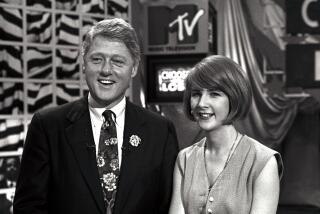Presentations for the MTV Generation
- Share via
The smell of balsa wood still makes John Greer queasy.
As director of development for an architecture firm, Greer and six colleagues labored for months on a one-sixteenth scale model of a proposed master-planned community in Florida. Palm trees, benches and lampposts were built to scale.
Greer and his toy subdivision arrived in Florida ready to wow his clients. But there was a glitch: His glorious model--10 feet by 5 feet--had to wait in the lobby because it didn’t fit in the boardroom.
That fiasco inspired Greer to launch La Jolla Group, an interactive media company that helps firms create digital presentations. Balsa wood models are taboo. Also shunned are 35mm slides, wooden pointers and overhead projections--styles Greer derisively refers to as “the leisure suits of the ‘90s.”
“Firms come to us with great ideas,” Greer says, “but many undersell their ideas by presenting them with yesterday’s technology.”
One client, Landrum & Brown, an airport planning and consulting firm, created a grand plan for a multibillion-dollar expansion of Los Angeles International Airport. But the memory left with the City Council, the mayor and hundreds of others who attended the presentation wasn’t one of forward-thinking ideas, but of blurry slides and hard-to-decipher designs.
Now, Joe Huy, a consultant at Landrum & Brown, pops a CD produced by La Jolla Group into his laptop, attaches a cable to a portable digital projector and is ready to flash his presentation on a movie theater-sized screen.
“The mix of video, graphics, photos, music and animation definitely holds an audience’s interest,” Huy says. “The virtual-reality type animation gives you the feeling that you are actually walking through the new terminal.”
Of course, a slick interactive presentation isn’t cheap--programs can start at $50,000. Nonetheless, the La Jolla Group, founded by Greer, 34, and Kouji Nakata in 1994, has picked up such clients as Arthur Anderson, Gas Co., Ritz-Carlton Huntington and UCLA Extension.
“We are becoming an MTV generation,” Greer says. “It’s not just teens who won’t sit still for 35mm slides. Adults have also come to expect a lively presentation.”
Most of Greer and Nakata’s staff have a background in computer graphic design or programming. Their basic software tools are Macromedia Director, Adobe Photoshop and Adobe Premiere.
Recently, the developer of a new high-rise apartment building in San Francisco hired the La Jolla Group to create an interactive presentation that will enable a prospective tenant to see, for example, what his view would look like if he bought a condo on the 42nd floor.
Nelson Communications Group, another La Jolla Group client, now passes out CDs rather than paper brochures. A feature of the Sacramento public relations firm’s digital brochure is its revealing look at staffers.
For instance, if a viewer clicks on the face of Thomas Wilck, a partner and executive vice president, a video of Wilck shows him in shorts, surfboard under his arm, running toward the surf.
As 1960s surf music plays, the scene cuts to footage of a surfer blasting out of a tube, then fades back to Wilck, his hair dry, standing on the beach in a sun hat and shades.
“I had a distinct career in public relations. Until now,” Wilck says. “Hey, man, things change--you have to catch the next wave.”
That’s just what Greer is telling his clients.
*
Gali Kronenberg is a freelance writer and regular contributor to The Times. He can be reached at gali.kronenberg@latimes.com
More to Read
The biggest entertainment stories
Get our big stories about Hollywood, film, television, music, arts, culture and more right in your inbox as soon as they publish.
You may occasionally receive promotional content from the Los Angeles Times.










